What Oil Does a Transfer Case Use? The Right Fluid for Your 4×4
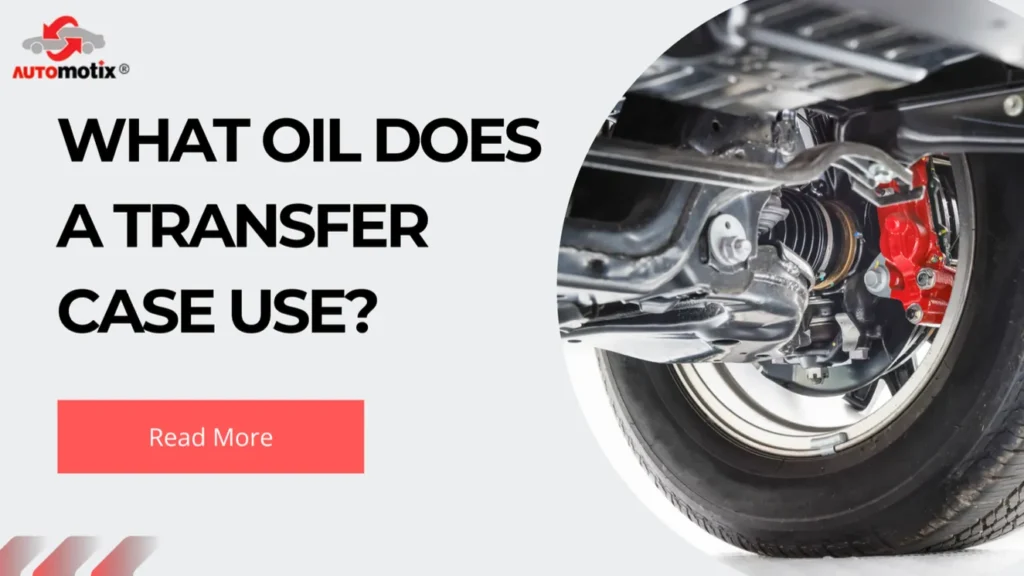
Introduction
There’s nothing quite like the thrill of hitting the trail in your 4×4, conquering challenging terrain, and exploring places most vehicles can only dream of. That feeling of power, control, and adventure? It’s largely thanks to the unsung hero tucked beneath your truck or SUV: the transfer case. This crucial component is the heart of your 4×4 system, seamlessly distributing power to all four wheels and allowing you to switch between different drive modes to tackle whatever lies ahead.
Yet, despite its vital role in your off-road escapades and daily drives, the fluid inside your transfer case is often one of the most overlooked aspects of 4×4 maintenance. Many vehicle owners diligently check their engine oil and transmission fluid, but the transfer case fluid can easily slip under the radar. This oversight is a common, and potentially costly, mistake.
Using the correct transfer case fluid isn’t just a recommendation; it’s essential for your 4×4’s performance, longevity, and ultimately, your wallet. The right fluid ensures smooth operation, prevents excessive wear, dissipates heat, and protects delicate internal components. Skimping on this vital detail can lead to sluggish performance, premature wear, and even complete transfer case failure, resulting in incredibly expensive repairs or replacements.
In this comprehensive guide, we’ll dive deep into the world of transfer case fluids. You’ll learn exactly what a transfer case does, why its fluid is so important, and most critically, how to determine the precise fluid your 4×4 needs. We’ll also cover essential maintenance tips to keep your transfer case running strong for years to come, ensuring your adventures never hit a roadblock.
Summary
In this comprehensive guide, we’ll demystify the transfer case, explaining its vital function in distributing power and enabling your 4×4’s diverse drive modes. We’ll then delve into the critical role of its fluid, detailing how it lubricates, cools, cleans, and protects this essential component. A detailed look at the various fluid types – including ATFs, MTFs, dedicated OEM fluids, and gear oils – will equip you with the knowledge to understand their unique characteristics. Most importantly, we’ll walk you through the definitive steps to determine the correct fluid for your specific 4×4, emphasizing the owner’s manual as your ultimate authority. Finally, we’ll cover essential maintenance practices, outline the significant dangers of using the wrong fluid, and explain why Automotix.net is your trusted source for quality used transfer cases should you ever need a replacement.
Table of Contents
- Understanding the Transfer Case
- The Critical Role of Transfer Case Fluid
- Types of Transfer Case Fluids
- How to Determine the Correct Fluid for Your 4×4
- Checking and Changing Your Transfer Case Fluid
- The Dangers of Using the Wrong Transfer Case Fluid
- Tips for Optimal Transfer Case Maintenance
- Why Automotix is Your Go-To for Used Transfer Cases
- Conclusion
- Frequently Asked Questions
Understanding the Transfer Case
What is a Transfer Case?

At its core, the transfer case is a specialized gearbox found in four-wheel-drive (4WD) and all-wheel-drive (AWD) vehicles. Think of it as the central command center for your vehicle’s power distribution. Its primary function is to distribute power from the transmission to both the front and rear axles. In simpler terms, it’s what allows your vehicle to send power to all four wheels when needed, rather than just two.
In a typical rear-wheel-drive (RWD) vehicle, power only goes to the back wheels. When you engage 4WD, the transfer case steps in, taking the rotational power from the transmission and splitting it, sending a portion to the front differential and another to the rear differential. This ingenious mechanism is what gives 4x4s and AWD vehicles their exceptional traction and capability.
Why is it so Important for 4×4 Vehicles?

For any true 4×4 enthusiast, the transfer case is absolutely indispensable. It’s the component that truly defines a 4×4 and differentiates it from a standard two-wheel-drive vehicle. Here’s why it’s so critical:
Enables Different Drive Modes: The transfer case is what allows you to seamlessly switch between various drive modes, offering incredible versatility:
- 2WD (Two-Wheel Drive): For everyday driving on paved roads, maximizing fuel efficiency. In this mode, power is typically sent only to the rear wheels (or sometimes the front, depending on the vehicle’s primary drivetrain).
- 4WD High (4H): Ideal for slippery conditions like snow, ice, or light off-road trails. The transfer case sends power to all four wheels, providing enhanced traction at higher speeds.
- 4WD Low (4L): This is where the real magic happens for serious off-roading. 4L provides maximum torque at lower speeds by multiplying the engine’s power. It’s essential for crawling over rocks, navigating steep inclines, pulling heavy loads, or getting unstuck from deep mud or sand.
Crucial for Off-Roading and Challenging Conditions: Without a properly functioning transfer case, your 4×4 is just a heavy 2WD vehicle. It’s the heart of your off-road capability, allowing you to:
- Maintain Traction: When one wheel loses grip, the transfer case (often in conjunction with differentials) helps redirect power to wheels that still have traction, preventing you from getting stuck.
- Conquer Obstacles: The low-range gearing in 4L provides the necessary torque to ascend steep hills, descend challenging slopes slowly and safely, and power through tough obstacles.
- Enhance Stability and Control: Distributing power to all four wheels significantly improves stability and control in adverse weather conditions or on uneven terrain.
In essence, the transfer case transforms your vehicle from a road-goer into an all-terrain explorer, ready to take on the wilderness.
The Critical Role of Transfer Case Fluid
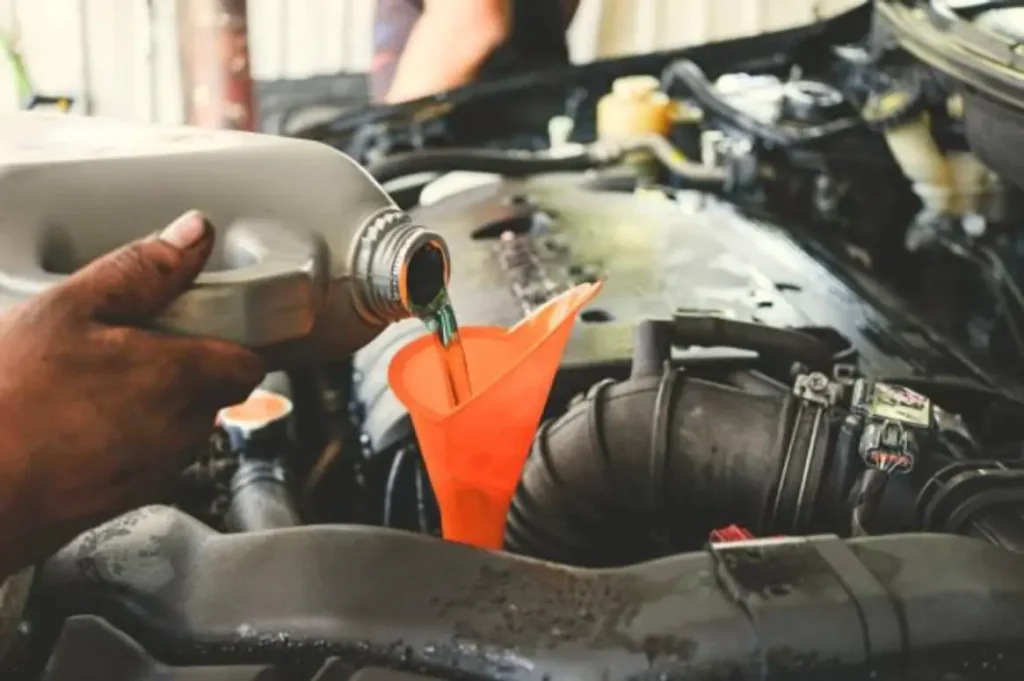
Just like the engine in your car or the transmission that shifts its gears, your transfer case relies on a specialized fluid to function correctly and reliably. This isn’t just “oil”; it’s a carefully engineered fluid designed to withstand extreme conditions and protect the complex internal components of the transfer case. Overlooking its importance is akin to running your engine without oil – a recipe for disaster.
Here’s why the fluid inside your transfer case is absolutely critical:
Lubrication: Reducing Friction Between Moving Parts
At its most fundamental level, transfer case fluid acts as a lubricant. Inside the transfer case, you’ll find a sophisticated array of gears, chains, shafts, and bearings constantly meshing and rotating at high speeds, often under immense pressure, especially during 4WD operation. Without adequate lubrication, these metal components would grind against each other, creating intense friction and heat. The fluid creates a thin, protective film that minimizes metal-to-metal contact, allowing these parts to glide smoothly. This drastically reduces wear and tear, ensuring the transfer case operates efficiently and quietly.
Cooling: Dissipating Heat Generated During Operation
Anytime mechanical parts move and create friction, heat is generated. In a transfer case, particularly during demanding conditions like off-roading, heavy towing, or prolonged 4WD use, this heat can build up rapidly. Transfer case fluid plays a vital role in dissipating this heat. As the fluid circulates, it absorbs thermal energy from the hot components and carries it away, often transferring it to the casing where it can cool. Without effective cooling, excessive heat can lead to fluid breakdown, component warping, seal failure, and ultimately, catastrophic damage to the transfer case.
Cleaning: Suspending Contaminants and Preventing Sludge Buildup
Even in a sealed environment, microscopic wear particles from gears and other components, along with potential contaminants like moisture, can accumulate over time. Transfer case fluid isn’t just passive; it actively works to clean the internal components. Its detergents and dispersants help to suspend these tiny particles and prevent them from settling and forming harmful sludge or varnish deposits. By keeping these contaminants suspended, they can be eventually removed when the fluid is changed, preventing them from abrading delicate surfaces or clogging internal passages.
Protection: Preventing Corrosion and Wear
Beyond lubrication, cooling, and cleaning, transfer case fluid provides crucial protection against corrosion and wear. Many transfer case fluids contain specialized additives that form protective layers on metal surfaces, guarding against rust and corrosion, which can occur from moisture ingress or chemical reactions. Furthermore, certain fluids include “extreme pressure” (EP) additives. These additives are particularly important for gears operating under heavy loads, as they form a sacrificial layer on metal surfaces that prevents direct metal-to-metal contact and scuffing, even when the lubricating film might momentarily break down under intense pressure. This comprehensive protection is essential for the long-term health and reliability of your transfer case.
Types of Transfer Case Fluids
The world of automotive fluids can be a bit like a labyrinth, and transfer case fluids are no exception. It’s not a “one-size-fits-all” scenario. Different transfer case designs, materials, and operational demands require specific fluid formulations to perform optimally and last. Understanding the primary categories of fluids used in transfer cases is the first step toward making the right choice for your 4×4.
Automatic Transmission Fluid (ATF)
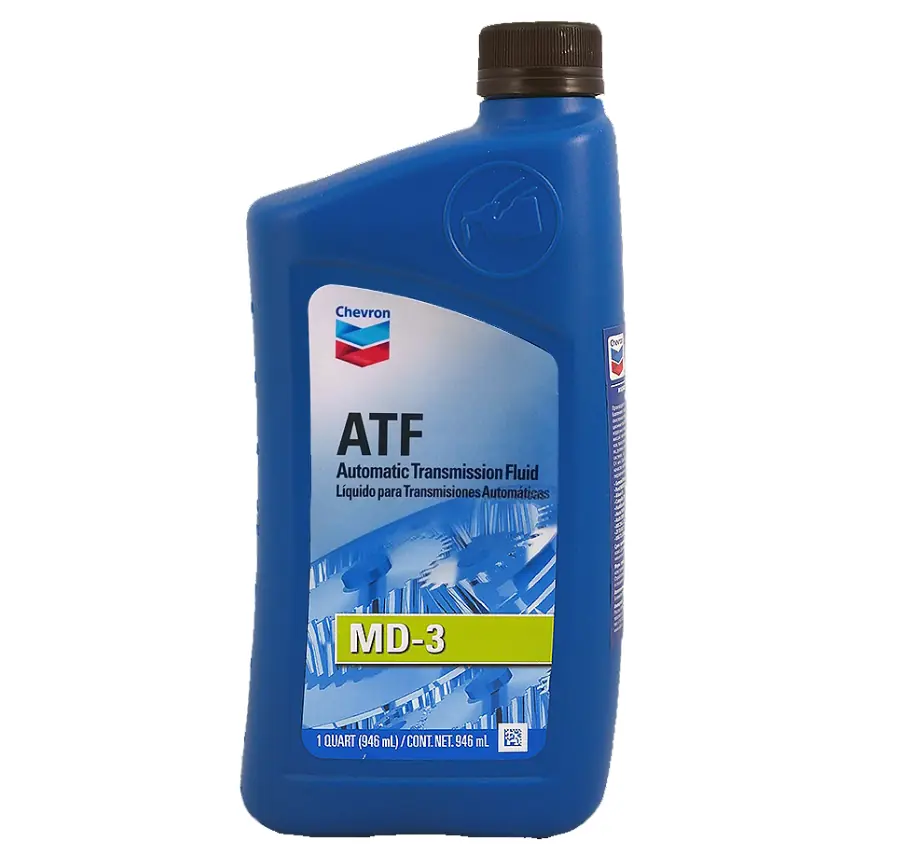
Surprisingly for some, Automatic Transmission Fluid (ATF) is one of the most commonly specified fluids for many modern transfer cases.
- Commonality: The reason for its widespread use lies in the design of many contemporary transfer cases. A significant number of transfer cases, particularly those found in lighter-duty trucks, SUVs, and all-wheel-drive vehicles, utilize internal chain drives and wet clutches for power transfer and engagement. The characteristics of ATF, especially its lubricating properties, friction modifiers, and ability to manage heat, are well-suited for these chain-driven designs. Furthermore, the fluid coupling inside many automatic transmissions shares some functional similarities with how power is transferred within these specific transfer cases.
- Specific Types: Just saying “ATF” isn’t enough; you need to pay attention to the specific type. Manufacturers often specify particular ATF formulations due to their unique additive packages and viscosity profiles. Common examples include:
- Dexron (e.g., Dexron III, Dexron VI): A GM specification, widely adopted by other manufacturers due to its excellent low-temperature performance and friction characteristics.
- Mercon (e.g., Mercon V): Ford’s equivalent specification, also known for its durability and friction modification properties.
- Chrysler ATF+4: A specific synthetic-blend ATF designed for many Chrysler, Dodge, Jeep, and Ram vehicles.
- Other OEM-Specific ATFs: Toyota Type IV, Honda Z1/DW-1, Nissan Matic-J/S, and many more exist, each tailored to the manufacturer’s precise requirements. Using the exact specified ATF is critical, as seemingly minor differences in friction modifiers or viscosity can lead to shuddering, noise, or premature wear in the transfer case.
- Characteristics: ATFs are generally characterized by their low viscosity (they’re relatively thin) and their robust additive packages. These additives provide excellent lubrication for internal chains and bearings, precise friction modification for clutch packs (where present), and superior heat dissipation. They are designed for efficient power transfer and are particularly good for chain-driven transfer cases that rely on consistent fluid properties for smooth engagement.
Manual Transmission Fluid (MTF)
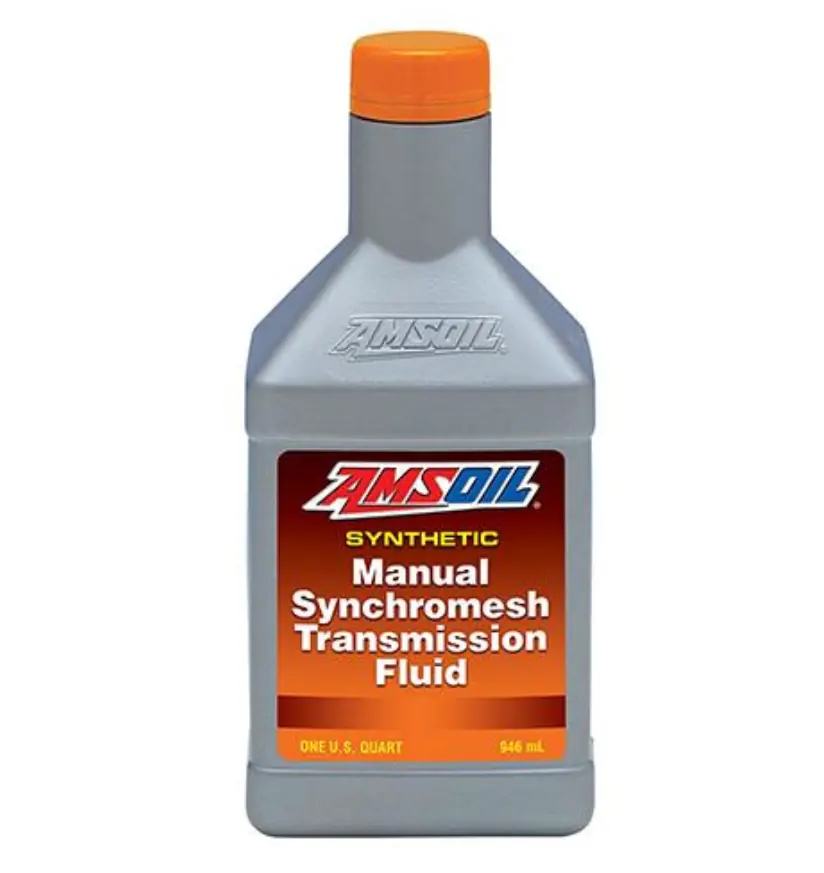
While less common than ATF, Manual Transmission Fluid (MTF) is specified for certain transfer
cases, particularly in older models or some heavy-duty applications.
- Less Common: You typically won’t find MTF in the chain-driven transfer cases common
today. Its use is generally restricted to transfer cases that have a gear-driven design
more akin to a manual transmission, or those where specific shear protection is needed. - Characteristics: MTFs typically have a higher viscosity than ATFs. They are designed
to lubricate gears that operate under different types of loads and often contain different
additive packages, including specialized friction modifiers and anti-wear agents, tailored
for the unique demands of manual gearbox components rather than the clutches or
chains found in many ATFs.
Dedicated Transfer Case Fluid
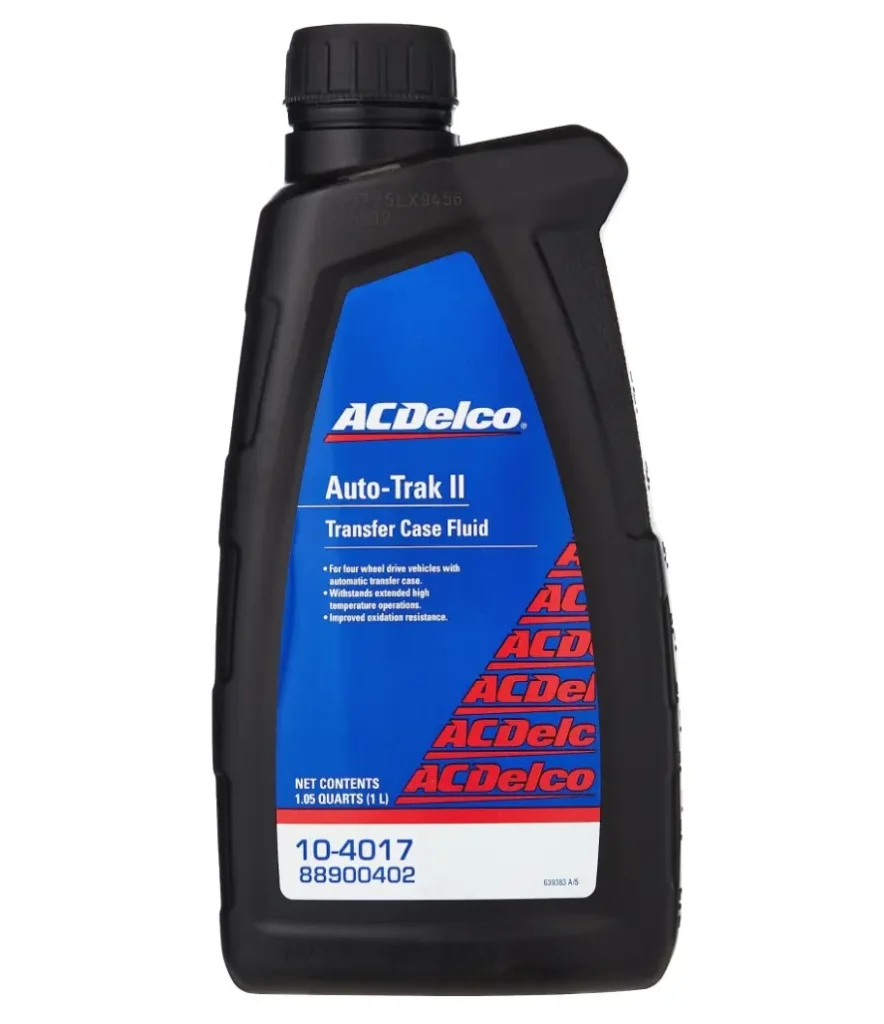
In an increasing number of modern vehicles, manufacturers are moving towards Dedicated
Transfer Case Fluids.
- OEM Specific: These are fluids designed and often marketed by the Original Equipment
Manufacturer (OEM) specifically for their unique transfer case designs. They typically
carry an OEM part number or a highly specific designation. Examples include:- GM AutoTrak II: Specifically formulated for GM’s AutoTrak active transfer cases.
- Ford Motorcraft XL-12: A highly engineered fluid for many Ford and Lincoln transfer cases.
- BMW xDrive Transfer Case Fluid: A specialized fluid for BMW’s intelligent all-wheel-drive systems.
- Mercedes-Benz Transfer Case Fluid: Another example of a highly proprietary fluid.
- Why They’re Different: These dedicated fluids are often highly sophisticated synthetic or synthetic-blend formulations with unique additive packages. They are precisely engineered to work with specific materials, tolerances, and electronic controls within a manufacturer’s particular transfer case design. They might contain specialized friction modifiers for clutch engagement, advanced anti-wear agents, or specific viscosity stabilizers to ensure optimal performance and longevity for that exact transfer case model. Substituting these with generic ATFs or gear oils can lead to improper engagement, noise, premature wear, or even failure, as the transfer case relies on the exact properties of these bespoke fluids.
Gear Oil
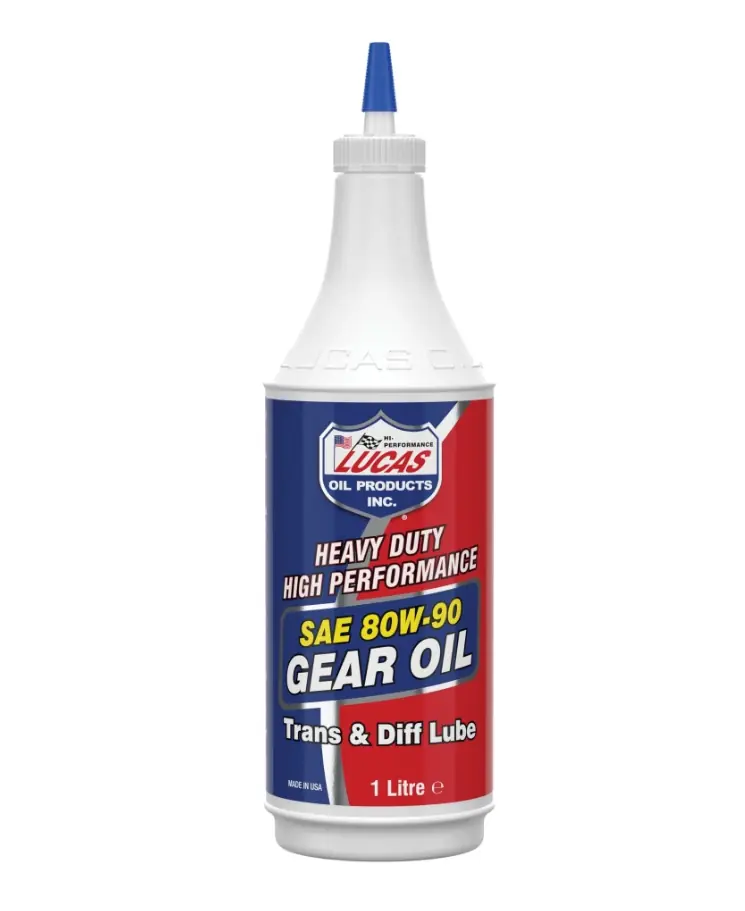
Gear Oil, often associated with differentials, also has a place in the history and present of transfer case fluids, though its application is becoming less common.
- Historical Use: Gear oils were more common in older, heavier-duty, or PTO (Power Take-Off)-driven transfer cases. These types of transfer cases often relied on robust, large-toothed gears rather than chains for power transfer, making them structurally similar to axles or manual transmissions that also use gear oil.
- Viscosity: Gear oils are characterized by their typically higher viscosity, often designated with an “SAE” rating followed by a “W” (for winter) and then a higher number, such as 75W-90, 80W-90, or 75W-140. This higher viscosity provides a thicker lubricating film suitable for heavy-duty gear sets operating under extreme pressure.
- Additives: A key characteristic of gear oils, especially those used in demanding applications, is the presence of EP (Extreme Pressure) additives. These additives, often sulfur-phosphorous based, create a protective chemical layer on gear surfaces that prevents metal-to-metal contact and scoring when high pressures occur, such as during heavy loads or shock impacts. While excellent for the sheer forces experienced by hypoid gears in differentials, these EP additives can sometimes be corrosive to “yellow metals” (like brass or bronze) found in synchronizers or bushings within some older transfer cases, which is another reason why knowing the correct specification is paramount.
How to Determine the Correct Fluid for Your 4×4
With a variety of transfer case fluid types out there, you might be wondering, “How do I figure out exactly which one my vehicle needs?” This is arguably the most crucial step in transfer case maintenance. Using the wrong fluid, even if it’s a “high-quality” product, can lead to serious problems. Don’t guess – rely on these definitive sources to ensure you choose correctly.
Your Owner’s Manual: The Ultimate Authority
When it comes to your vehicle’s specifications, your owner’s manual is the undisputed, primary, and most reliable source of information. Period. Automakers spend countless hours testing and validating every component and fluid recommendation. This manual contains the precise fluid types and capacities your vehicle’s engineers determined are optimal for its design and performance.
- Where to find the information: Look for sections typically titled “Maintenance” “Specifications” “Capacities” or “Lubricants and Fluids.” Within these sections, you’ll usually find a subsection specifically detailing the transfer case fluid type, often alongside the recommended service interval and fill capacity. Some manuals even include a fluid chart that lists all the required fluids by component. If you’ve lost your physical manual, most manufacturers offer free digital versions for download on their official websites by simply entering your vehicle’s VIN or make, model, and year.
Manufacturer Specifications (OEM Part Numbers/Fluid Types)
Beyond the owner’s manual, delving into the manufacturer’s official documentation can provide further clarity, especially if you’re dealing with an older vehicle or a less common transfer case.
Checking the manufacturer’s website or service bulletins: Most major automotive manufacturers have dedicated “service information” or “parts” sections on their official websites. Here, you can often find detailed specifications, fluid charts, and sometimes even service bulletins that might update or clarify fluid recommendations for specific models or transfer case units. Parts departments at official dealerships are also excellent resources; they can look up the exact OEM fluid part number required for your specific vehicle.
Understanding OEM fluid designations: Manufacturers often have their own proprietary names and part numbers for their recommended fluids (e.g., GM AutoTrak II, Ford Motorcraft XL-12, Nissan Matic-S, etc.). While these might sound generic, they represent highly specific formulations tailored to their transfer cases. Always prioritize these OEM-specified fluids or reputable aftermarket equivalents that explicitly state they meet that specific OEM specification. Don’t just match based on the fluid’s base type (e.g., “Dexron-compatible”) without verifying the specific designation.
Vehicle Information
Having your vehicle’s precise details at hand is crucial for accurate fluid identification,
particularly when consulting parts suppliers or online forums.
- Make, Model, Year: This foundational information is always the starting point. For example, “2015 Ford F-150” or “2008 Jeep Grand Cherokee.”
- Specific transfer case model: While not always necessary for newer vehicles if you have your manual, knowing the actual transfer case model (e.g., NP208, NP242, BW4406, NV247) can be incredibly helpful. This is often stamped on a tag on the transfer case itself or can be found in a factory service manual. Different transfer cases, even within the same make and model line, can sometimes use different fluids. For instance, a Jeep Grand Cherokee with an NV247 Quadra-Trac II transfer case might use a specific fluid, while another Grand Cherokee with an NV245 Quadra-Drive II might require something different due to its electronic limited-slip differential components.
Visual Inspection (if applicable)
While not a definitive method for identifying the type of fluid, a visual inspection can sometimes offer clues or confirm existing information.
Checking labels near the fill plug or on the transfer case itself: Some transfer cases, particularly older models or those with unique fluid requirements, may have a small label or stamp near the fill plug indicating the required fluid type (e.g., “Use ATF,” “Gear Oil Only”). Always double-check this against your owner’s manual.
Fluid color and consistency (though not a definitive guide for type): When you eventually drain the old fluid, its color and consistency can tell you about its condition (e.g., burnt smell, dark color indicating degradation, milky appearance indicating water contamination). However, fluid color alone is not a reliable indicator of its type. While new ATF is typically red or clear, and gear oil is often amber, these colors can change significantly with age and use, and some newer specialized fluids are dyed various colors. Never rely solely on color to determine the required fluid specification.
Checking and Changing Your Transfer Case Fluid
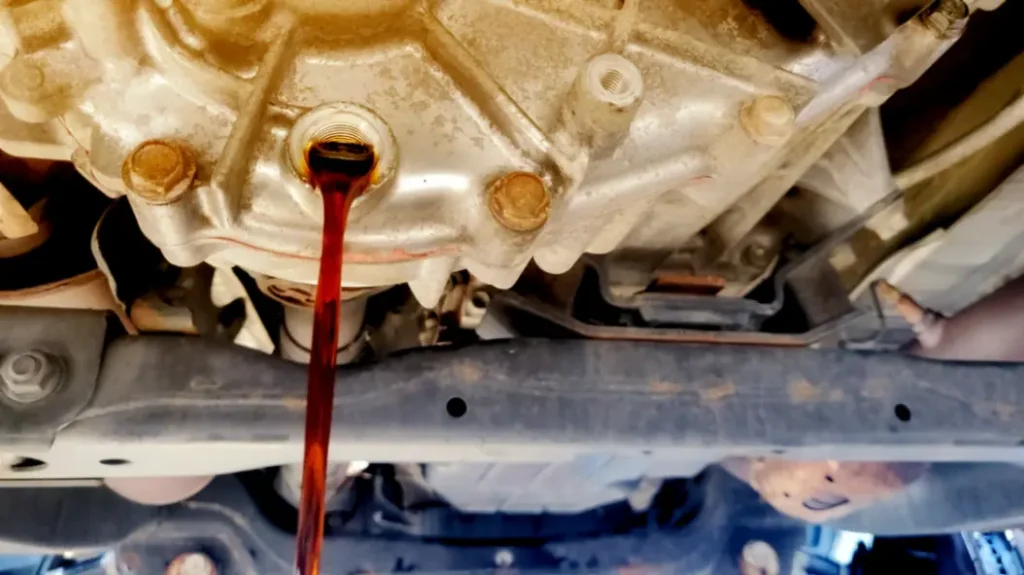
You’ve learned what a transfer case does and why its specific fluid is so vital. Now, let’s talk about the practical side: knowing when and how to maintain that fluid to ensure your 4×4 continues to perform flawlessly for years to come.
When to Check and Change
Unlike engine oil, which has a fairly universal change interval, transfer case fluid schedules can vary significantly.
- Manufacturer’s Recommended Service Intervals (Mileage/Time): Your owner’s manual (that ultimate authority we discussed) is your go-to source here. It will specify a recommended mileage or time interval for checking and replacing the transfer case fluid. For many vehicles, this might be every 30,000 to 60,000 miles, or every few years, but some can go longer. Always adhere to these guidelines as a minimum.
- Factors That Might Necessitate Earlier Changes (Heavy Towing, Off-Roading): The manufacturer’s recommended intervals are typically for “normal” driving conditions. If your 4×4 regularly faces more demanding situations, you’ll need to shorten those intervals.
- Heavy Towing: Constantly pulling heavy loads puts extra strain and generates more heat within the transfer case.
- Frequent Off-Roading: Mud, water crossings, rock crawling, steep inclines, and prolonged use of 4WD Low all significantly increase the operating temperature and stress on the transfer case, accelerating fluid breakdown.
- Extreme Temperatures: Operating in very hot or very cold climates can also affect fluid life. If you engage in these activities, consider changing your transfer case fluid at roughly half the recommended interval, or even more frequently, depending on the severity of use. It’s cheap insurance against costly repairs.
Signs of Low or Contaminated Fluid
Your 4×4 often gives you subtle (or not-so-subtle) hints when its transfer case fluid is in distress.
Pay attention to these warning signs:
- Unusual Noises (Whining, Grinding): A low fluid level or degraded fluid can lead to inadequate lubrication, causing gears and chains to whine, grind, or clunk, especially when shifting into or out of 4WD, or under load.
- Difficulty Shifting Into/Out of 4WD: If your vehicle hesitates, struggles, or refuses to engage or disengage 4WD, contaminated or incorrect fluid could be a culprit. Modern electronically controlled transfer cases rely on precise fluid properties for clutch engagement.
- Leaking Fluid: Any visible fluid drips or puddles under the transfer case indicate a leak. Low fluid levels rapidly lead to increased friction, heat, and eventual damage. Leaks typically originate from seals (e.g., input, output, or case seals) that can dry out or fail.
- Dark, Burnt-Smelling Fluid: While you won’t know this until you drain it, if the old fluid is extremely dark, cloudy, or has a distinct burnt odor, it indicates severe degradation from heat and contamination. This fluid has lost its lubricating and protective properties and needs immediate replacement.
Basic Steps for DIY Fluid Change (Brief Overview, Emphasize Safely)
Changing your transfer case fluid is often a straightforward DIY task for the mechanically
inclined, but safety is paramount. If you’re unsure at any step, please consult a professional
mechanic.
- Safety Precautions (Jack Stands, Proper Tools):
- Always work on a level surface.
- Use sturdy jack stands to support the vehicle after lifting it with a jack. Never rely solely on a jack.
- Wear appropriate personal protective equipment (PPE), including safety glasses and gloves.
- Gather all necessary tools beforehand: a drain pan, wrenches or sockets for drain and fill plugs (ensure you have the correct size/type, as some are hex or square drive), a fluid pump or syringe for refilling, and shop rags.
- Ensure the vehicle is cool. Fluid changes are best done when the components are warm (for better flow) but not scorching hot.
- Locating Drain and Fill Plugs:
- The transfer case typically has two plugs: a fill plug (usually higher up on the case) and a drain plug (at the bottom).
- Always loosen the fill plug FIRST. This is a critical step! If you drain the fluid and then can’t open the fill plug, you’re stuck.
- Draining the Old Fluid:
- Once the fill plug is loose, place your drain pan underneath the drain plug.
- Carefully remove the drain plug. The fluid will likely be under slight pressure and may come out quickly. Allow all the old fluid to drain completely. Inspect the fluid for color, smell, and any metal particles, which could indicate internal wear.
- Clean any metal shavings from the magnetic tip of the drain plug (if equipped).
- Refilling with the Correct Fluid:
- Reinstall the drain plug and tighten it to the manufacturer’s specified torque. Do not overtighten.
- Using your fluid pump or syringe, begin adding the correct new transfer case fluid through the fill plug opening.
- Continue filling until the fluid just starts to seep out of the fill hole. This indicates the correct level.
- Reinstall the fill plug and tighten it to the manufacturer’s specified torque.
- Clean up any spilled fluid and dispose of the old fluid responsibly at an approved recycling center.
The Dangers of Using the Wrong Transfer Case Fluid
We’ve emphasized the importance of using the correct transfer case fluid throughout this guide, and for good reason. While it might seem like a minor detail to some, the consequences of using the wrong fluid are anything but trivial. What might appear to be a cost-saving measure or an innocent mistake can quickly escalate into severe problems, impacting your vehicle’s reliability and your wallet.
Component Damage
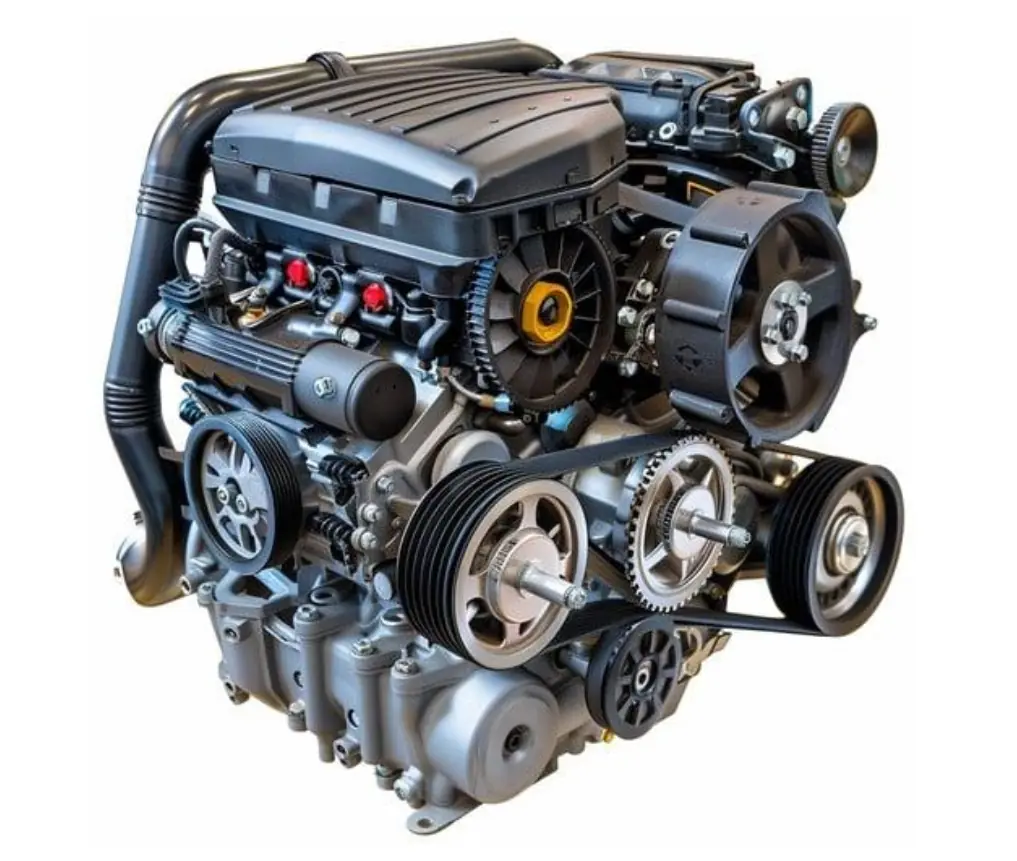
The most immediate and severe consequence of using an incorrect fluid is accelerated wear
and damage to the internal components of your transfer case. Each fluid type is formulated with
a specific viscosity, friction modifiers, and additive packages tailored to the design and materials
of a particular transfer case.
Accelerated wear on gears, chains, and bearings: If the fluid is too thin, it won’t provide an adequate lubricating film, leading to metal-on-metal contact, increased friction, and rapid wear of the delicate gears, chains, and bearings. If it’s too thick, it can create excessive drag, leading to higher operating temperatures and inefficient power transfer. Incorrect friction modifiers (especially critical in transfer cases with wet clutches) can cause shuddering, excessive slip, or premature wear of clutch packs.
Overheating and breakdown of seals: Fluids that don’t dissipate heat effectively or have improper viscosity can cause the transfer case to run hotter than intended. This excessive heat can harden and crack seals and gaskets, leading to fluid leaks. Once seals fail, fluid levels drop, further exacerbating wear and potentially leading to complete system failure. Some fluid chemistries are also incompatible with certain seal materials, leading to their degradation over time.
Reduced Performance

Beyond physical damage, using the wrong fluid will inevitably lead to a noticeable reduction in your 4×4’s performance.
- Inefficient power transfer: The transfer case is designed to efficiently distribute power. An incorrect fluid can lead to increased drag, slippage, or improper engagement of internal components. This translates to less power making it to your wheels, especially under demanding conditions, reducing your vehicle’s overall capability.
- Difficulty engaging 4WD: Modern transfer cases, particularly those that are electronically controlled or feature active engagement systems (like GM’s AutoTrak or Ford’s Control Trac), rely heavily on precise fluid properties for smooth and timely engagement and disengagement of 4WD modes. The wrong friction characteristics can cause hesitation, harsh engagement, or even prevent the system from engaging 4WD altogether. You might experience clunks, grinding, or simply a warning light indicating a 4WD system fault.
Voided Warranty

For owners of newer vehicles, one of the most significant risks is voiding your manufacturer’s warranty. Automakers explicitly state the required fluids for their vehicles in the owner’s manual and service literature.
- Manufacturer may deny claims due to incorrect fluid use: If a transfer case failure occurs, and a dealership or independent mechanic determines that an incorrect fluid was used (or that fluid maintenance was neglected), the manufacturer has every right to deny your warranty claim. This leaves you, the owner, solely responsible for the full cost of diagnosis and repair, which can be substantial. Always keep records and receipts of fluid purchases and maintenance if you perform the work yourself.
Costly Repairs

Ultimately, all the aforementioned dangers culminate in one painful reality: costly repairs.
Replacing a damaged transfer case can be expensive: A complete transfer case replacement is not a minor repair. Depending on your vehicle’s make, model, and the complexity of its transfer case, a new or remanufactured unit can range from hundreds to several thousands of dollars, not including significant labor costs for removal and installation. Compare this to the relatively modest cost of a few quarts of the correct fluid, and the choice becomes clear. Investing in the proper fluid and adhering to maintenance schedules is the most economical way to ensure the long-term health of your transfer case.
Tips for Optimal Transfer Case Maintenance
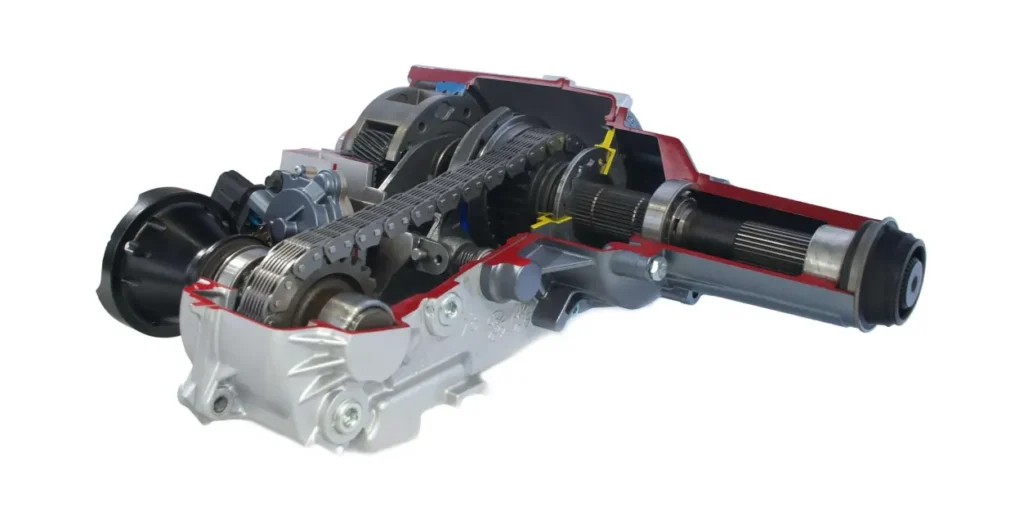
Maintaining your transfer case doesn’t have to be complicated, but it does require attention and diligence. By following these straightforward tips, you can significantly extend the life of your transfer case, avoid unexpected breakdowns, and ensure your 4×4 is always ready for its next adventure. Think of these as your personal guidelines for proactive protection.
Regular Fluid Checks: Make It Part of Your Routine Vehicle Inspection
Don’t wait until you experience a problem to think about your transfer case fluid. Just like you check your engine oil, make a habit of visually inspecting your transfer case area whenever you’re under the vehicle or performing other maintenance.
Look for leaks: Pay attention to any drips or wet spots around the transfer case housing, seals (front and rear output shafts, input shaft), and plugs. Even small leaks can lead to a critical loss of fluid over time.
Monitor general condition: While you can’t check the fluid level directly without removing the fill plug, a quick visual can alert you to external damage or excessive grime build-up that might hide a leak.
Adhere to Service Intervals: Don’t Skip Recommended Fluid Changes
Your owner’s manual provides the most accurate and reliable schedule for transfer case fluid
changes. This isn’t an arbitrary recommendation; it’s based on extensive engineering and
testing.
Follow the manufacturer’s guidelines: Whether it’s every 30,000, 60,000, or 100,000 miles, stick to the prescribed intervals. These intervals are designed to ensure the fluid maintains its protective properties throughout its lifespan under normal operating conditions.
Adjust for severe service: As discussed, if you regularly engage in heavy towing, frequent off-roading, or drive in extreme climates, consider shortening the recommended service interval. These demanding conditions put immense stress on the fluid, causing it to degrade faster. A good rule of thumb for severe use is to change the fluid at half the recommended mileage or time.
Address Leaks Immediately: Small Leaks Can Quickly Become Big Problems
A tiny drip today can quickly turn into a significant loss of fluid tomorrow, leading to irreversible
damage.
- Don’t ignore drips: If you spot any signs of fluid leakage around your transfer case, get it inspected by a qualified mechanic immediately. Leaks often indicate failing seals or gaskets that need to be replaced.
- Top off, then repair: While temporarily topping off the fluid might prevent immediate damage, it’s not a solution. The underlying leak must be addressed to ensure long-term reliability and safety.
Use Quality Fluids: Don’t Cut Corners on Fluid Quality
The temptation to save a few dollars by opting for cheaper, generic fluids can be incredibly
costly in the long run. The transfer case is a precision component, and it requires fluids that
meet specific, often complex, specifications.
Prioritize OEM-specified fluids: Whenever possible, use the exact OEM (Original Equipment Manufacturer) fluid specified in your owner’s manual. These fluids are engineered to perfectly match your transfer case’s design, materials, and operational requirements.
Choose reputable aftermarket equivalents carefully: If an OEM fluid isn’t readily available or you prefer an aftermarket option, ensure it explicitly states that it meets or exceeds your vehicle’s specific OEM specification (e.g., “Meets Ford Motorcraft XL-12 spec,” or “Compatible with Dexron VI applications”). Research brands and read reviews to ensure you’re getting a high-quality product from a trusted source. Never use a fluid just because its bottle says “transfer case fluid” without verifying the specific compatibility.
Professional Inspection: Consider Periodic Professional Checks, Especially If You Off-Road Frequently
Even with diligent DIY maintenance, a professional eye can catch potential issues before they become serious.
- Benefits of expert assessment: A qualified mechanic can perform a thorough inspection of your transfer case, checking for subtle leaks, unusual wear patterns, or early signs of internal problems that might not be obvious during a basic visual check. They can also use specialized diagnostic tools to check the function of electronic transfer cases.
- Peace of mind for off-roaders: If your 4×4 sees regular duty on challenging trails, a pre- or post-season professional check can provide invaluable peace of mind, ensuring all components are in top shape to handle the rigors of off-road adventures.
Why Automotix is Your Go-To for Used Transfer Cases

Even with meticulous maintenance, sometimes a transfer case reaches the end of its life, or an unexpected failure occurs. When that happens, finding a reliable, high-quality replacement is paramount. That’s where Automotix.net steps in. As a leading provider of used auto parts, we understand the critical role your transfer case plays, especially for 4×4 enthusiasts. We’re not just a parts supplier; we’re a partner in keeping your adventures going.
Quality Assurance
At Automotix, “used” doesn’t mean “uncertain.” We stand by the quality of our used transfer cases through a rigorous, multi-point testing and inspection process.
- Thorough Vetting: Every transfer case that comes into our inventory undergoes a meticulous evaluation. We check for common failure points, signs of excessive wear, and external damage.
- Functional Testing: Where applicable, units are tested to ensure proper engagement of 2WD, 4WD High, and 4WD Low, as well as smooth operation. We look for any unusual noises, vibrations, or leaks that would indicate a problem.
- Fluid Condition Analysis: While we always recommend changing fluids upon installation, we also assess the condition of the fluid found within the drained unit to gain insights into its previous operational health. This commitment to quality assurance means you receive a part that’s been vetted for reliability, giving you confidence in your replacement.
Extensive Inventory
The transfer case market is diverse, with numerous designs across countless vehicle makes
and models. Automotix prides itself on maintaining an extensive inventory to meet this variety.
- Broad Coverage: Whether you drive a classic Jeep, a robust Ford F-Series, a versatile Chevy Silverado, or a modern Toyota Tacoma, chances are we have the right used transfer case for your specific year, make, and model.
- Hard-to-Find Units: We often stock units for older or less common vehicles, helping you avoid the frustration of searching for obscure parts. Our vast network allows us to source a wide range of transfer cases, from common chain-driven units to more specialized electronic and gear-driven assemblies.
Expert Knowledge
Choosing the right transfer case, especially a used one, can be daunting. Our team at
Automotix isn’t just about selling parts; we’re about providing solutions and expertise.
- Informed Assistance: Our knowledgeable staff understands the intricacies of 4×4 systems and can help you verify compatibility, answer questions about different transfer case models (e.g., distinguishing between an NP208 and an NP241, or a BW4406 and a BW4419), and ensure you’re getting the exact part you need for your vehicle.
- Guidance and Support: We can assist you in navigating the details, helping you confirm OEM part numbers or identify your specific transfer case model to ensure a perfect fit.
Convenience
We understand that when your 4×4 is down, you need a replacement part quickly and without
hassle.
Nationwide Delivery: Automotix offers fast and reliable nationwide delivery across the USA. No matter where you are, we can get your quality used transfer case to your doorstep efficiently.
Easy Ordering Process: Our website, Automotix.net, is designed for a straightforward and user-friendly experience. You can easily search for parts by make, model, year, and even VIN, making the ordering process quick and seamless.
Reliability
We stand behind the quality of our products, offering peace of mind that’s often hard to find with
used auto parts.
Robust Warranties: Automotix provides competitive warranties and guarantees on our used transfer cases. This demonstrates our confidence in our testing and inspection process, giving you an added layer of protection and assurance in your purchase. Always check the specific warranty terms for the part you are interested in.
Customer Satisfaction: Our commitment to customer satisfaction means we strive to ensure you’re happy with your purchase and that your vehicle gets back on the road (or off-road) as quickly as possible.
Precision Fitment with Hollander Interchange
Forget the guesswork. We utilize the industry-standard Hollander Interchange cataloging system to ensure 100% fitment for your vehicle. This sophisticated system allows us to cross-reference parts across different makes and models, guaranteeing that the used axle you receive is the perfect match for your car’s specific year, make, and model.
When a replacement transfer case is necessary, don’t compromise on quality or reliability. Choose Automotix.net for a trusted, tested, and guaranteed used transfer case that will help you resume your 4×4 adventures with confidence.
Conclusion
You now know that the transfer case is far more than just another component in your 4×4; it’s the very heart of its all-terrain capability. From enabling those thrilling 4WD adventures to ensuring safe navigation through challenging conditions, its role is indispensable. And as we’ve thoroughly explored, the often-overlooked transfer case fluid is absolutely critical to its proper function, longevity, and overall reliability.
Understanding the different types of fluids—from various ATFs and MTFs to dedicated OEM-specific formulations and gear oils—and knowing precisely which one your vehicle requires is paramount. Using the wrong fluid, or neglecting fluid changes, isn’t just a minor oversight; it’s an express lane to accelerated wear, reduced performance, potentially voided warranties, and ultimately, staggeringly expensive repairs.
Therefore, our final advice is clear: Embrace proactive maintenance. Make checking for leaks a routine, always adhere to your manufacturer’s recommended service intervals (and shorten them if you engage in severe driving), insist on using only the correct, high-quality fluid, and don’t hesitate to seek professional advice when needed. A small investment in time and the right fluid today can save you from major headaches and costly repairs down the road, ensuring your transfer case remains a reliable workhorse for countless miles and adventures to come.
Need a replacement transfer case? Don’t let a faulty unit sideline your 4×4. Explore Automotix.net’s extensive inventory of quality, tested used transfer cases today and get back on the trail with confidence!Have questions about your 4×4’s transfer case or need help finding the right part? Contact our experts! We’re here to provide the knowledge and support you need.
Frequently Asked Questions
Q: What is the most important thing to know about transfer case fluid?
A: Always use the exact type of fluid specified in your vehicle’s owner’s manual. Different transfer cases require different fluids (ATF, dedicated fluid, or gear oil), and using the wrong one can cause serious damage.
Q: How often should I change my transfer case fluid?
A: Follow your vehicle’s owner’s manual for recommended intervals (typically 30,000 to 60,000 miles). If you frequently tow heavy loads or off-road, consider changing it more often.
Q: What are the signs that my transfer case fluid needs attention?
A: Look for unusual noises (whining, grinding), difficulty shifting into/out of 4WD, fluid leaks, or dark/burnt-smelling fluid when inspecting.
Q: Can I use automatic transmission fluid (ATF) in my transfer case?
A: Only if your owner’s manual specifically states to use ATF. Many modern transfer cases do use specific types of ATF, but others require dedicated transfer case fluid or gear oil. Never assume they’re interchangeable.
Q: Why is using the correct transfer case fluid so important?
A: The right fluid lubricates, cools, cleans, and protects internal components. Using the wrong fluid can lead to accelerated wear, overheating, seals breaking down, reduced 4WD performance and costly repairs, potentially even voiding your warranty.
About the Author / Automotix Team:
This guide was crafted by the seasoned experts at Automotix, a leading name in the used auto parts industry since 2000. With over two decades of dedicated experience, our team has been at the forefront of connecting buyers with high-quality, certified used OEM auto parts across the USA. We pride ourselves on leveraging cutting-edge technology to streamline the auto parts buying experience, offering an unparalleled inventory and a commitment to customer satisfaction that has established us as a trusted authority. Our mission is to empower car owners, DIY mechanics, and repair shops with the knowledge and the right parts to keep vehicles running efficiently and affordably, contributing to both individual savings and a more sustainable automotive future.
